Inside the Jordan refugee camp that runs on blockchain
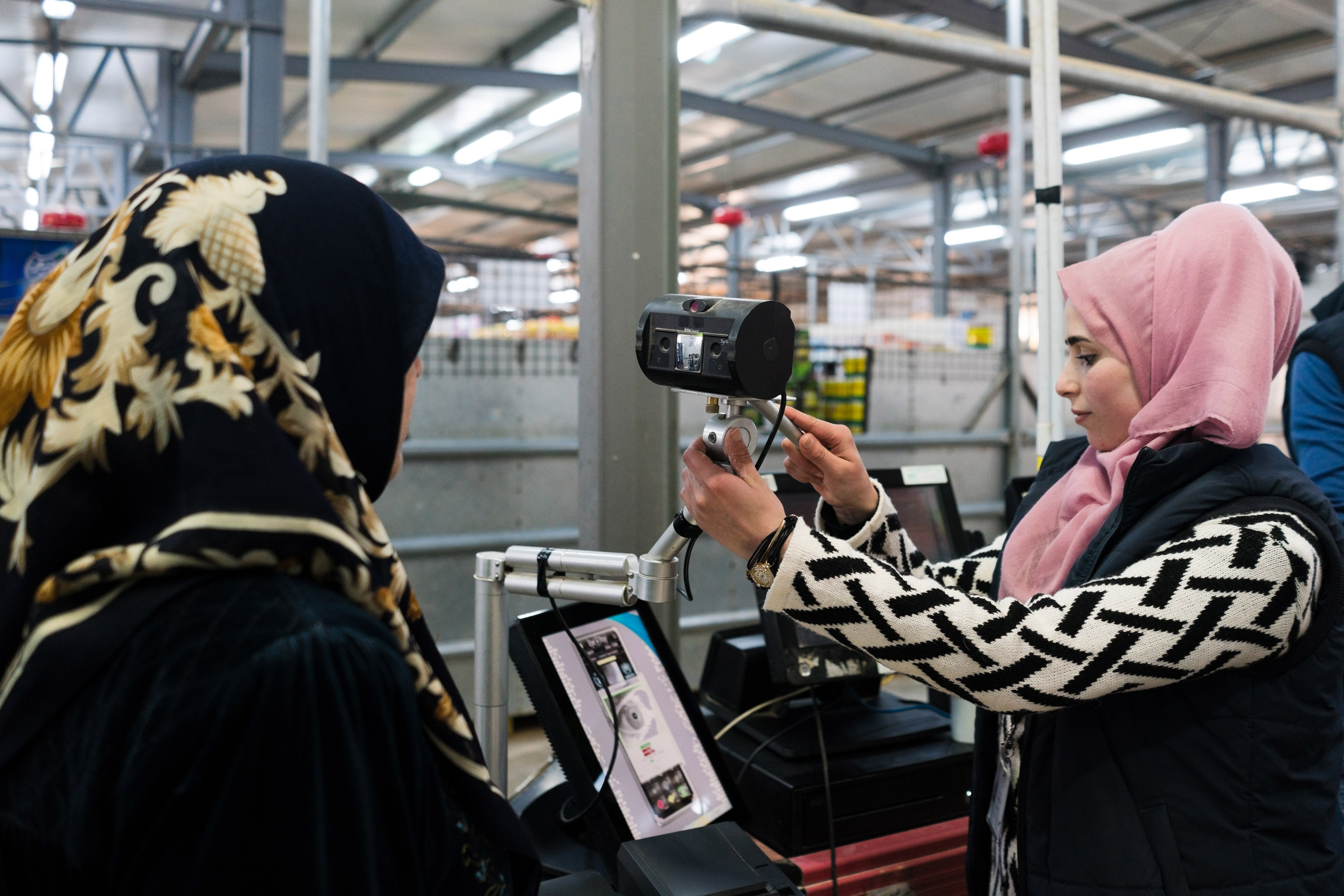
A few times a month, Bassam pushes a shopping cart through the aisles of a grocery store stocked with bags of rice, a small selection of fresh vegetables, and other staples. Today he’s wearing a black sweater tucked into denim jeans, which are themselves tucked into calf-high boots caked in mud. The Tazweed Supermarket, where he’s shopping, is on the periphery of a 75,000-person refugee camp in the semi-arid Jordanian steppe, six and a half miles from the Syrian border.
At the checkout counter, a cashier tallies the total, but Bassam doesn’t pay with cash or a credit card. Instead he lifts his head to a black box and gazes into the mirror and camera at its center. A moment later, an image of Bassam’s eye flashes on the cashier’s screen. Bassam collects his receipt—which reads “EyePay” and “World Food Programme Building Blocks” across the top—and walks out into the noonday chaos of the Zaatari refugee camp.
Though Bassam may not know it, his visit to the supermarket involves one of the first uses of blockchain for humanitarian aid. By letting a machine scan his iris, he confirmed his identity on a traditional United Nations database, queried a family account kept on a variant of the Ethereum blockchain by the World Food Programme (WFP), and settled his bill without opening his wallet.
Started in early 2017, Building Blocks, as the program is known, helps the WFP distribute cash-for-food aid to over 100,000 Syrian refugees in Jordan. By the end of this year, the program will cover all 500,000 refugees in the country. If the project succeeds, it could eventually speed the adoption of blockchain technologies at sister UN agencies and beyond.
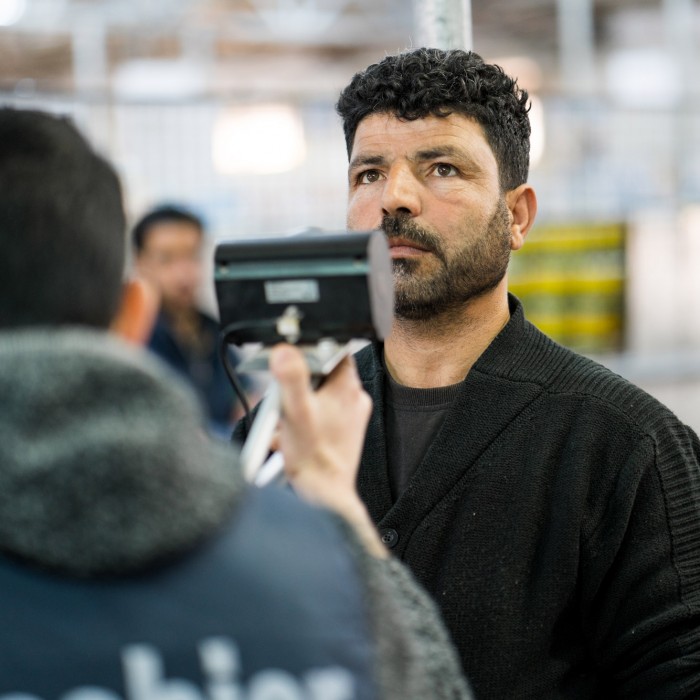
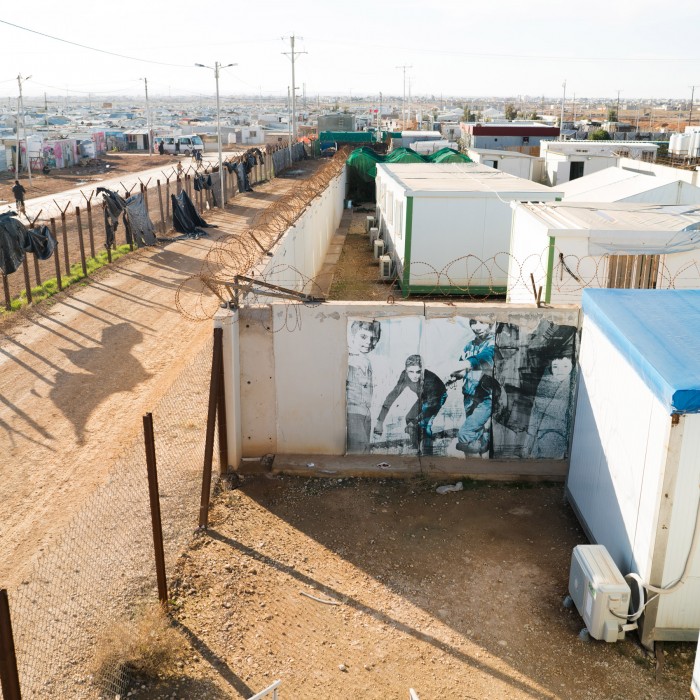
(Left) Bassam gets his eye scanned to pay at the market’s checkout. (Right) A mural at the Zaatari camp.
Building Blocks was born of a need to save money. The WFP helps feed 80 million people around the globe, but since 2009 the organization has shifted from delivering food to transferring money to people who need food. This approach could feed more people, improve local economies, and increase transparency. But it also introduces a notable point of inefficiency: working with local or regional banks. For the WFP, which transferred over $1.3 billion in such benefits in 2017 (about 30 percent of its total aid), transaction and other fees are money that could have gone to millions of meals. Early results of the blockchain program touted a 98 percent reduction in such fees.

And if the man behind the project, WFP executive Houman Haddad, has his way, the blockchain-based program will do far more than save money. It will tackle a central problem in any humanitarian crisis: how do you get people without government identity documents or a bank account into a financial and legal system where those things are prerequisites to getting a job and living a secure life?
Owning your identity
Haddad imagines Bassam one day walking out of Zaatari with a so-called digital wallet, filled with his camp transaction history, his government ID, and access to financial accounts, all linked through a blockchain-based identity system. With such a wallet, when Bassam left the camp he could much more easily enter the world economy. He would have a place for an employer to deposit his pay, for a mainstream bank to see his credit history, and for a border or immigration agent to check his identity, which would be attested to by the UN, the Jordanian government, and possibly even his neighbors.
Such a record, perhaps stored on a mobile phone, could let someone like Bassam take his data from Syria to Jordan and beyond, backed up online in encrypted form. Syrian refugees using such a system—and most in Zaatari already have smartphones—could regain legal identities that were lost along with their documents and assets when they fled their homes. In this scenario, Bassam could move—to Germany, or back to Syria—and easily prove his educational credentials, demonstrate his relationship to his children, and get a loan to start a business. (In most countries, without an ID you can’t get a bank account, and without a bank account, you can’t get a place to live or a legal job.)
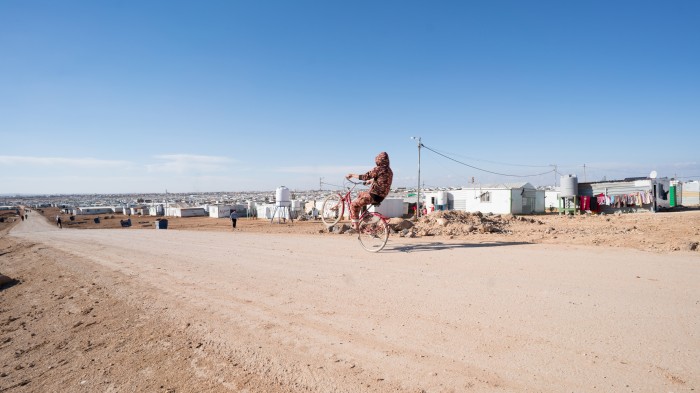
If such a system had existed before Bassam left his hometown of Daraa, he might have avoided Zaatari altogether and become a productive member of Jordanian society straight away. Even if Syria revoked his passport, or if a school with a record of his degrees were bombed, an immutable register of his history could still smooth his entry into an adopted country.
A number of organizations are already working on aspects of this idea. In Finland, a blockchain startup called MONI has collaborated since 2015 with the Finnish Immigration Service, giving every refugee in the country a prepaid MasterCard—backed by a digital identity number stored on a blockchain. Even without the passport necessary to open a Finnish bank account, a MONI account lets refugees receive benefits directly from the government. The system also allows refugees to get loans from people who know and trust them, helping them build rudimentary credit histories that could make it possible to get institutional loans down the road.
Meanwhile, companies like Accenture and Microsoft are joining nonprofit organizations in a public-private alliance called ID2020. The mission is to help achieve the UN goal of providing a legal identity to everyone, starting with the 1.1 billion people who lack any officially recognized proof of their existence.
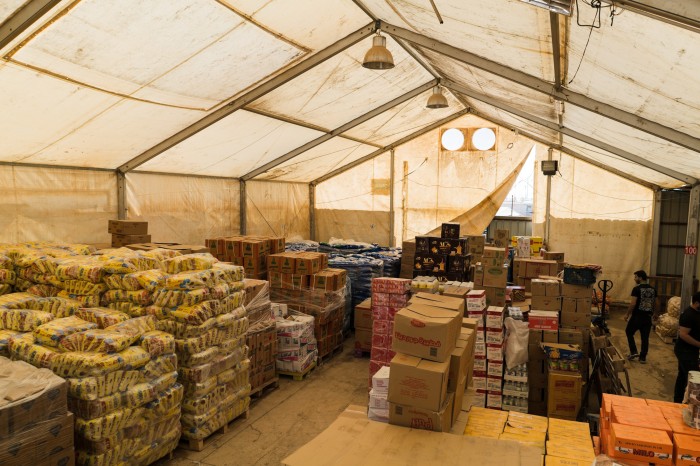
At the heart of such systems is a concept known as “self-sovereign identity.” It was popularized in 2016 by Christopher Allen, an American technologist, who outlined principles for a digital proof of existence owned by the individual. In such a scheme, identity would be portable and not dependent on any state or central authority. And the consensus is growing that a blockchain should be at its center.
Blockchains, Allen told me, are critical to such identity systems because they solve previously “unsolvable” problems. By storing an encrypted identifier in a blockchain, one can separate the authentication system from one’s data, helping to protect privacy. Blockchain systems are also more secure than conventional identity records because they cut out third-party intermediaries. They can be easier to use, and they can survive disasters that might wipe out more centralized record-keeping systems.
The ultimate goal is a system in which a user owns and totally controls some kind of digital wallet—much like the physical one we carry today for our paper documents. The wallet stores claims made by the user (like name and date of birth), evidence for those claims (like copies of birth certificates or utility bills), and third-party validations, known as attestations, that further support an individual’s claims (like a government confirmation of the details on a birth certificate). Such a wallet could reside in a smart chip on a key fob or something resembling a credit card, or it could be a secure enclave within one’s phone, like those already provided by some manufacturers.
With the right technology, say Haddad and others, a blockchain ID system could cover many more claims than the kind found on licenses or passports—claims like “over 21” or “US citizen.” It might, for example, help a refugee prove his or her professional background or family connections.
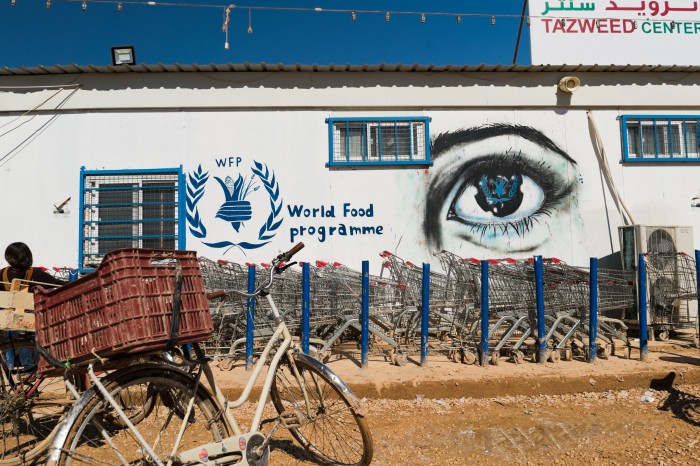
Who controls it?
It will take a while to achieve that grand vision. Haddad’s idea for Building Blocks was to start by creating an account on a blockchain for every family of Syrian refugees in a Jordanian camp. Families wouldn’t then have to wait days for local banks to transfer their money, or have to share identifying information with the banks, where some unscrupulous employee might steal or misuse it. Meanwhile, the WFP, instead of forwarding money before it’s spent, could itself tally all refugee purchases and pay participating stores afterward in local currency. That’s a big deal, since upwards of 30 percent of UN assistance is lost to corruption.
In an early test of the Building Blocks payment idea in Pakistan, however, the transactions were slow and the fees were too high. Haddad decided one of the problems was that the system was built on the public Ethereum blockchain. The current version of Building Blocks—the one now in use in Jordan—runs on a “permissioned,” or private, version of Ethereum.
On a public blockchain, anyone can join the network and validate transactions. Such a system makes it difficult for any one person or agency to tamper with or forge transactions, but transaction fees tend to add up. On a permissioned blockchain, a central authority decides who can participate.
The upside of the permissioned system is that Haddad and his team can process transactions faster and more cheaply. The downside is that since the WFP has control over who joins its network, it also has the power to rewrite transaction histories. Instead of cutting the banks out of the equation, it has essentially become one.
For Bassam and his fellow refugees in Zaatari, the distinction may not matter. Bassam told me he’d bought groceries with an iris scan even before Building Blocks was implemented, but in that case an actual bank handled the transaction. And before that, he had a card the cashier would scan, but sometimes it wore out, and it could take weeks to get it replaced. “The new system works better,” he says.
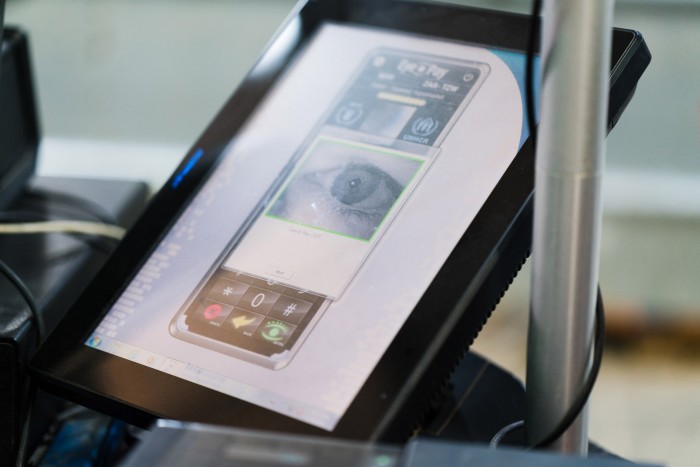
“It’s a major success,” says Haddad, who explains that it reduces costs and the risks of sharing refugees’ data, while simultaneously improving the WFP’s control, flexibility, and accountability. “Now if we get a call that 20,000 people are coming in the night, we can have everything ready for them in the morning,” he says. “The old way would have taken two weeks and required paper vouchers.”
But because Building Blocks runs on a small, permissioned blockchain, the project’s scope and impact are narrow. So narrow that some critics say it’s a gimmick and the WFP could just as easily use a traditional database. Haddad acknowledges that—“Of course we could do all of what we’re doing today without using blockchain,” he says. But, he adds, “my personal view is that the eventual end goal is digital ID, and beneficiaries must own and control their data.”
Other critics say blockchains are too new for humanitarian use. Plus, it’s ethically risky to experiment with vulnerable populations, says Zara Rahman, a researcher based in Berlin at the Engine Room, a nonprofit group that supports social-change organizations in using technology and data. After all, the bulk collection of identifying information and biometrics has historically been a disaster for people on the run. Think of the Holocaust, or the more recent ethnic cleansing of Rohingya in Myanmar.
A matter of courage
Ultimately, the question with Building Blocks or any similar system is whether it will put ownership of digital IDs in the hands of the people being represented or simply become an easier way for corporations and states to control people’s digital existence. Bob Reid, CEO of a blockchain identity startup called Everid, told me he expects a battle over this question in the next few years. “Either it goes to individuals or it goes to major institutions that will mine our data,” he says. Still, he says, the hope is that the discussion will move away from such either-or framing.

The real promise of using blockchains may not be realized until organizations like the WFP and the UN have the courage to open at least parts of the system to other agencies, and then to take the bravest step of all and turn over ownership of the data to beneficiaries like Bassam, who currently has little say in the matter because he has to be in the system if he wants to eat.
Building Blocks could, in theory, accomplish this if it evolves according to Haddad’s vision. For instance, the WFP could offer its technology to others as a basic accounting system, tracking disbursements for food and later adding entries for land ownership, educational credentials, and travel history. If outside nonprofit organizations were allowed to add nodes to the blockchain’s network, it could become more like a public blockchain, with its advantages of being harder to hack or cripple because it is decentralized and distributed.
Walking around Zaatari, a bustling city that sprang into existence as a tidal bore of humanity crashed over the Syrian border in 2012, shows what a severe test it will be for Building Blocks’ ambitions. Just beyond the two officially sanctioned grocery stores that accept payments using Building Blocks, there are scores of mom-and-pop vendors openly running what are essentially black-market shops selling everything from food to washing machines to old bicycles. If Building Blocks can’t be adopted there, then aside from making the WFP’s operations a bit more efficient and transparent, it will remain little more than a centrally controlled database dressed in a costume of distributed, decentralized trust.
Russ Juskalian is a freelance writer based in Munich, Germany. He visited Zaatari this February.
Keep Reading
Most Popular
Large language models can do jaw-dropping things. But nobody knows exactly why.
And that's a problem. Figuring it out is one of the biggest scientific puzzles of our time and a crucial step towards controlling more powerful future models.
How scientists traced a mysterious covid case back to six toilets
When wastewater surveillance turns into a hunt for a single infected individual, the ethics get tricky.
The problem with plug-in hybrids? Their drivers.
Plug-in hybrids are often sold as a transition to EVs, but new data from Europe shows we’re still underestimating the emissions they produce.
Stay connected
Get the latest updates from
MIT Technology Review
Discover special offers, top stories, upcoming events, and more.